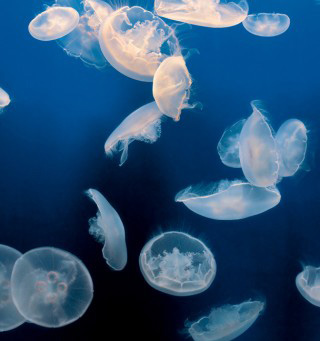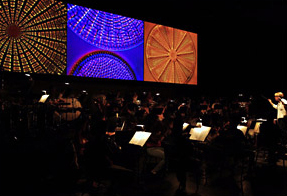By Stephen Brookes • The Washington Post • February 2, 2007
_______________________________________________________________________________________
Walking on a beach about seven years ago, Frans Lanting had an epiphany. The National Geographic photographer was shooting pictures of horseshoe crabs crawling out of the ocean, and suddenly realized that the creatures hadn't changed in hundreds of millions of years; he was looking directly into the distant origins of life.
 That moment set Lanting on an epic, six-year photographic journey around the world "with the simple idea," as he puts it, "of looking for the past in the present." The final result -- which premiered last summer in California -- was a spectacular, hour-long exploration of the evolution of life on earth, with some 200 of Lanting's most vivid images set to a score by the minimalist composer Philip Glass.
That moment set Lanting on an epic, six-year photographic journey around the world "with the simple idea," as he puts it, "of looking for the past in the present." The final result -- which premiered last summer in California -- was a spectacular, hour-long exploration of the evolution of life on earth, with some 200 of Lanting's most vivid images set to a score by the minimalist composer Philip Glass.
The East Coast got its first look at "Life: A Journey Through Time" at the Music Center at Strathmore on Thursday night, when the Baltimore Symphony Orchestra presented it as part of the Explorer series. The project is a feast for both eyes and ears -- Lanting's majestic photographs dance lightly across a huge screen over the orchestra, while some of Glass's most elegant music pulses underneath. It's a celebration of nature in all its glory -- from modest lichens to vast, erupting volcanoes.
And yet, while it's a completely enjoyable way to spend an hour, "Life" doesn't really fulfill the ambitious promise of its title. It drifts through the eons, checking off points on the timeline but telling no particular story, connecting no interesting dots and offering no new insights, and the images seem chosen more for their beauty than anything else. As visual entertainment, it's lovely. As a serious meditation on evolution, it disappoints.
To be fair, the production was never intended as a Discovery Channel special. Lanting is a gifted nature photographer, and his images (especially on this scale) are spellbinding -- scorpions preparing to strike, hulking stromatolites stretching into a primal dawn, cheetahs charging across the African plain. And it's worth the price of admission just to see a 40-foot jellyfish float lovingly over conductor Marin Alsop's head.
It was also good to hear the music of Glass played by the BSO. Baltimore is Glass's home town, yet he's been shamefully ignored by the orchestra -- though that may be about to change. Alsop, the incoming BSO music director, understands Glass's music deeply (she once played in the Philip Glass Ensemble), and her handling of the score was beautifully detailed and evocative -- a stunning performance sure to whet concertgoers' appetites.

Alsop conducting the premiereAnd it was an inspired choice to pick Glass for this project; his short, cellular motifs slowly replicate, transform and blend their musical DNA to form greater and more complex shapes -- all with the implacable industriousness of evolution itself. The score (actually a pastiche of previous works, stitched together and orchestrated by Michael Riesman) kept "Life" moving forward smoothly, and sat fatly in the ears.
Another Glass work, the 1995 Concerto for Saxophone Quartet, opened the program. And whether you think Glass writes music of transcendent poetry or just cranks out tedious nonsense for slow thinkers, the Concerto is one of his more charming works, with an engaging blend of soaring lyricism and jazzy, metropolitan thrust. The Capitol Quartet brought the work alive with personality, enthusiasm and warmth -- matched fully by Alsop and the BSO players.
____________________________________________________
Note: the program will be repeated Saturday 2/24 at 8 pm, and Sunday 2/25 at 3 pm, at Meyerhoff Symphony Hall in Baltimore. Lanting will also be talking about his work at the National Geographic Society in DC on Tuesday 2/27.
The Baltimore Sun's Tim Smith was also at Thursday's performance; check out his review here.